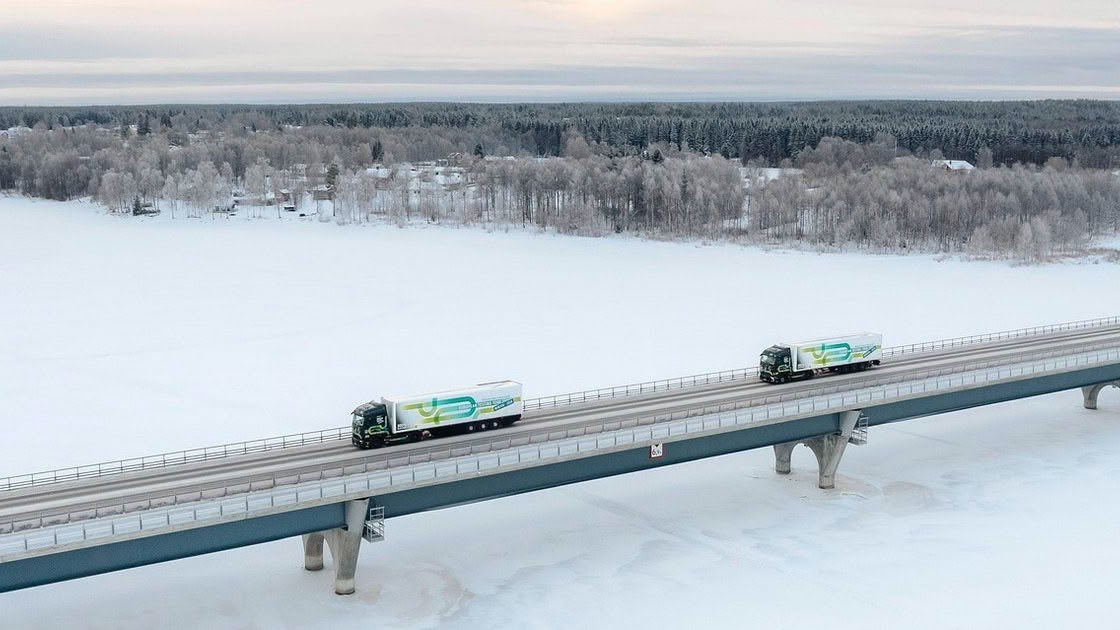eActros 600 undergoes final winter testing

Mercedes-Benz Trucks has once again sent its two near-production prototypes of the eActros 600 on a testing tour through Northern Europe – but this time during the cold season in sometimes very wintry conditions.
The objective of the “European Testing Tour Winter 2025” was to test the practicality of the battery-electric eActros 600 – which has since been awarded the International Truck of the Year 2025 and is in series production – in representative winter operation in Northern Europe on different routes and topographies as well as in different climate zones, gaining important insights into the effect of winter temperatures and road conditions on the energy consumption of the eActros 600.
Of the around 6500km covered through Northern Europe, over half of the tour took place on identical routes to the northern part of the almost seven-week European Testing Tour that took place in summer 2024. Once again, the two trucks were on the road with a gross combination mass of 40 tonnes.
“Not only are we interested in how the energy consumption of the eActros 600 behaves in different winter operations, but above all our customers and drivers,” said Christof Weber, head of global testing at Mercedes-Benz Trucks.
The 16-day tour set off northwards in mid-January from Wörth am Rhein. The route first went through Germany, Denmark, Sweden, and Finland to the Arctic Circle. It then went back to Stuttgart and Wörth via Estonia, Latvia, Lithuania, Poland, the Czech Republic, and Austria.
On their journey through ten countries in Northern Europe, the electric trucks were sometimes on the road at extreme temperatures between -18 and 9 degrees Celsius. The daily average speeds ranged from 64 to 77km/h.
Aerodynamics and rolling resistance have a major influence on energy consumption of battery-electric long-distance trucks in winter
“Ultimately, aerodynamics and rolling resistance have a considerable influence on the consumption of a truck – regardless of the drive type,” said Jochen Gottstein, manager testing energy consumption & range at Daimler Truck.
“The higher air density at lower temperatures in winter always leads to increased air resistance – and thus to increased consumption.
“The tires required for driving in winter also have greater rolling resistance and increase consumption – the wintrier the road conditions, the better the tires’ grip needs to be and the higher the consumption.”
A more detailed analysis of a representative section of the route, which was completed after a cold start at an average temperature of -2 degrees Celsius and on energy efficiency class B tires on a snow-free road surface, shows an increase in consumption of approximately 25 percent compared to the same distance on efficiency class A tires. Five percent of this is due to the climate control of the cab at a pleasant 21 degrees Celsius. Less than one percent was used to heat the battery. Other auxiliary consumers accounted for well below one percent of the additional consumption. Roughly four percent of this was caused by lower recuperation power compared to the summer, which is largely due to increased rolling and air resistance. At around 15%, the latter account for the remaining lion’s share of the increase in consumption.
On particularly demanding routes with predominantly snow-covered and partially icy roads, the increased energy consumption rose to almost 50% compared to driving in summer on efficiency class A tires. This is primarily due to the significantly increased motion resistance. The drive-independent rolling resistance of the energy efficiency class D Scandinavian tires designed for these extreme winter conditions played a significant role in this.
Pleasant temperatures when driving, living, and sleeping in the driver’s cab have little influence on the range.
This means that drivers do not have to freeze in the eActros 600 or scrimp on heating, even in winter. For example, the four engineers covered almost 3000km in the first five days and spent day and night in their trucks.
“During the day, we set the temperature to 21 degrees Celsius and at night to 19 degrees Celsius for sleeping – at outside temperatures between -7 and 4 degrees Celsius,” said Werner Kempfle, development engineer and co-project manager of the eActros 600.
“This only led to a reduction in range of two to five percent. With regard to total consumption, the so-called “hoteling” share is therefore hardly significant, and even with a battery-electric eActros 600, you don’t have to worry about not being able to reach your destination as a result of heating the cab.”
Suitable public truck charging infrastructure remains the exception
As in the summer, the electric trucks were charged exclusively at public charging stations in the winter.
“Although it is still challenging to find charging options specifically designed for trucks, we found some state-of-the-art charging parks in Scandinavia in particular, where we did not have to unhitch our trailers and where there was sufficient charging capacity and good infrastructure for driving breaks,” said Gottstein.
Especially in winter, in very cold temperatures and snow, this is a great relief for the drivers.
“Ultimately, however, we also have to admit that this was rather the exception, and that charging infrastructure still needs to be expanded in most of the cases we have seen,” he said.





